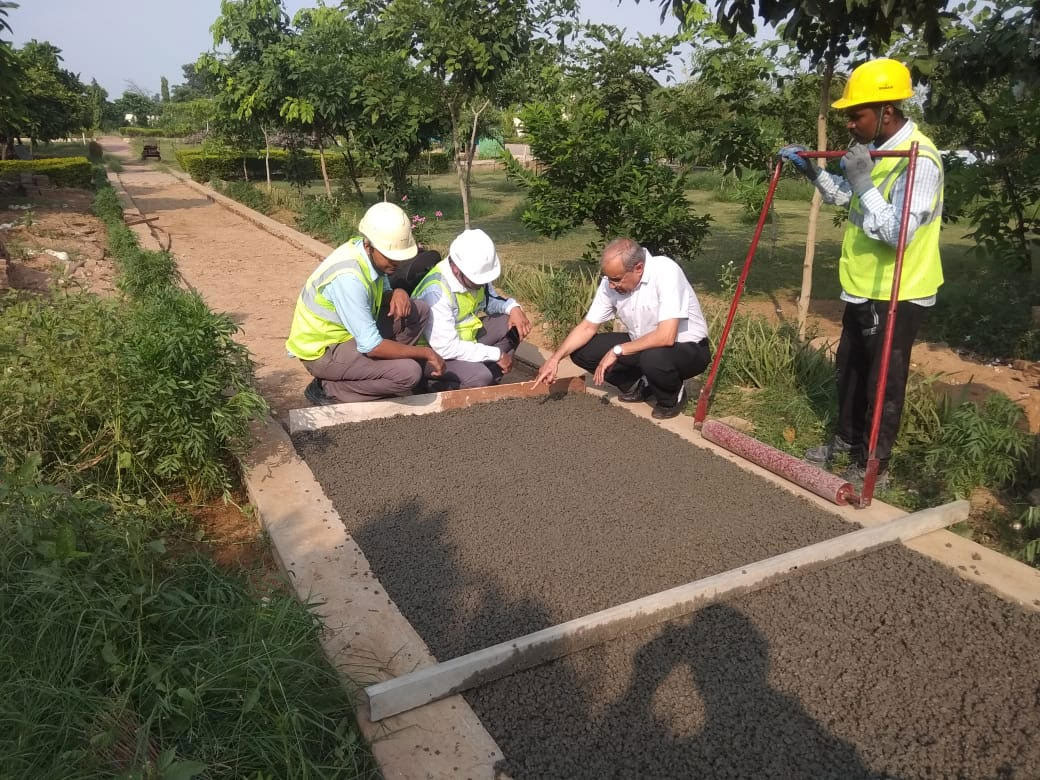Jagvir Goyal
Resistance to moisture and refusal to seepage of water are known properties of concrete used by us in our houses and structural components. We want concrete to be impregnable to any sort of moisture and keep a low water cement ratio to impart maximum strength and least porosity to concrete. However, the manufacturers engaged in the production and marketing of cement and concrete have now come out with the concept of ‘pervious concrete’ that has its own uses. Let’s have a look:
What is pervious concrete? Contrary to the properties of normally produced concrete used in building foundations, beams, columns and slabs, pervious concrete has high porosity and allows water to easily pass through it. Because of its high porosity property, it is called pervious concrete.
How is it produced? Pervious concrete is especially produced concrete that uses least or no sand in it. Thus this type of concrete has cement, coarse aggregate of 10 mm or 20 mm size, little or zero quantity of sand and water as its ingredients. The mix design of this type of concrete is evolved by keeping a compressive strength of 150 to 180 kg per sq. cm as the desired strength. The concrete has an optimum cement paste content that binds a well graded coarse aggregate. The aggregate is narrowly graded to achieve uniform porosity of concrete.
Special properties: While designing pervious concrete, it is kept in view that it has a designed porosity of 15% to 25%. The size of pores in it is designed to be between 0.5 mm to 0.8 mm. Its drainage rate of water is also worked out and checked. The concrete is designed to drain out between 300 litres to 500 litres of water per square meter per minute.
Uses of Pervious concrete: The question rises that why such a porous concrete should be produced at all. The answer lies in its environmental benefits. If this concrete is used in horizontal surfaces like walkways with a properly designed sub-base, it can substantially help in ground water recharging. Further, it can lead to reduced cost of storm water drainage system due to reduced runoff and reduced water harvesting arrangements.
Where to use? Best use of pervious concrete is in the walkways and parking areas where light traffic is expected. Its concrete surface helps in providing better skid resistance to traffic during rainfalls. If provided in the paving and pathways in the green pastures, it will help in better growth of trees as it doesn’t retain water but allows it to pass through to the earth. Ponding of water on surfaces leading to false steps, glare at night or accidents can also be eliminated by using pervious concrete. Despite being porous but because of its proper mix design and strength, it has excellent durability and requires minimum maintenance.
How to have best results? For achieving best results in walkways, paving and pathways, a step by step approach should be adopted. The concrete mix with desired strength and uniform porosity should be designed and ordered to a concrete producing plant. Special care should be taken to use a narrowly graded coarse aggregate as the sand, generally used in other concretes as filler material is absent in this concrete. The sub-grade of the pathway where the concrete is to be laid should be compacted well. Over the sub-grade, a base course of material should be laid. This base course should have stone pebbles of 8 inch to 24 inch size laid well over compacted sub-grade. Over this sub-base, the pervious concrete layer should be placed. The thickness of pervious concrete should be 4 inch to 6 inches. The concrete layer should now be cured well for at least seven days to allow the concrete to gain full strength.
Cost of pervious concrete: As the ready mix concrete producing and selling plants generally have many orders for normally used concrete for structural sections, they may demand little more time and cost for pervious concrete supply unless the order placed is for quite large volume of concrete. Yet, on average, rate of supply of pervious concrete should be around Rs. 5000 per cubic meter of concrete. It may be little higher if the lead involved from the plant to the point of use is more than 30 km.
Minimum quantity: For a ready mix concrete plant, an order for supply of a new type of concrete shall be feasible only if certain minimum quantity is ordered to it. A concrete plant will generally accept an order if the quantity of concrete is not less than 20 cum. It is better to include pumping of concrete in the order. In that case, the concrete is produced, transported to site and pumped directly to desired location and all these activities are inclusive in the rate. However, if the order for concrete is less than 20 cubic meters, in that case, its supply through transit mixer shall be suitable. In this case, concrete can be unloaded at site and got placed in position by engaging labour for that. For very small quantity of concrete, buckets can be used and suppliers generally fulfil the order by supplying concrete filled in buckets.
Avoid preparing at site: As the pervious concrete has little or no sand; needs a well graded coarse aggregate and has to have uniform porosity yet good compressive strength, one should avoid its preparation at site like commonly used concrete but order its supply to a reliable RMC plant. Many plants located in tri-city and in DeraBassi now accept orders for supply of well produced pervious concrete. Such plants should show instant acceptability for orders of pervious concrete to make it popular and to help in achieving its environmental benefits through easy drainage and ground water recharging.


